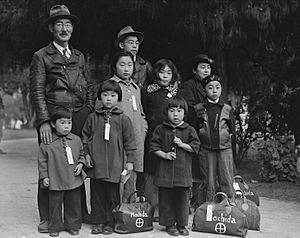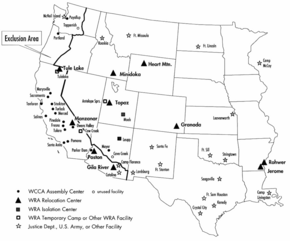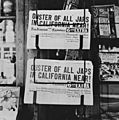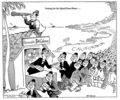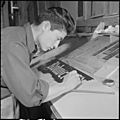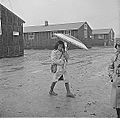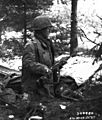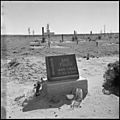Japanese American internment facts for kids
Quick facts for kids Japanese American Internment |
|
|---|---|
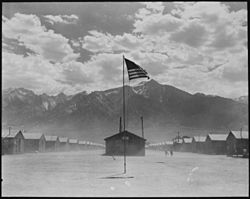
Manzanar internment camp for Japanese Americans
|
|
| Operation | |
| Period | February 1942 – June 30, 1946 |
| Location | United States |
| Cause | Attack on Pearl Harbor; racism; war hysteria |
| Victims | |
| Total | Over 110,000 Japanese Americans, including over 66,000 U.S. citizens, forced into internment camps |
| Deaths | 1,862 from disease in camps |
During World War II, the United States government forced about 110,000 Japanese Americans to leave their homes. They had to live in special places called internment camps, which were like prisons. Many of these people were born in the United States and were U.S. citizens.
Contents
Why Internment Happened
On December 7, 1941, Japan attacked Pearl Harbor in Hawaii. This started a war between Japan and the United States. Many Americans were very angry. Some people unfairly blamed all Japanese Americans for the attack.
There were false rumors that some Japanese Americans knew about the attack beforehand. They were accused of helping the Japanese military. The FBI and other parts of the U.S. government knew these rumors were not true. But they did not tell the public.
Japanese Americans started to feel that other Americans were upset with them. For example, a radio news reader in Los Angeles, California said bad things about Japanese Americans for about a month. Some businesses put up mean signs. These signs showed how much anger and prejudice there was against Japanese Americans.
The Start of Internment

In February 1942, President Franklin D. Roosevelt signed an order called Executive Order 9066. This order allowed the government to remove people from certain areas of the country. Even though the order did not specifically say "Japanese Americans," everyone knew it was about them.
The areas included all of California and the western parts of Oregon, Washington, and Arizona. Most Japanese Americans lived in these areas. To stop them from leaving on their own, the government made it hard for them to take money from their bank accounts. This made it very difficult for them to move freely.
Japanese Americans were given only 48 hours to pack and leave for internment camps. They could only bring one bag with them. They were not allowed to bring radios or cameras.
My family were Americans. We were citizens of this country. We had nothing to do with the war. We simply happened to look like the people that bombed Pearl Harbor. But without charges, without trial, without due process—the [most important part] of our justice system—we were summarily rounded up, all Japanese Americans on the West Coast, where most of us lived, and sent off to 10 barb wire internment camps—prison camps, really, with [guard] towers, machine guns pointed at us.I was a five-year old, we lost everything. - George Takei
Who Was Interned
In total, the United States forced over 110,000 Japanese Americans into internment camps. About 80% of all Japanese Americans living in the continental United States were forced to leave their homes. More than three out of every five of these people were U.S. citizens, meaning they were born in America.
Most of the interned Japanese Americans lived in the continental U.S. About 160,000 Japanese Americans lived in Hawaii. However, only a little over 1,000 of them were interned there. This was because there were so many Japanese Americans in Hawaii that interning them all would have been almost impossible.
Life in the Camps
Three different government agencies ran the camps. Most Japanese Americans (90%) were in camps run by the War Relocation Authority (WRA). Only Japanese Americans lived in these WRA camps.
The other 10% of Japanese Americans were in mixed-race camps. These were run by the Immigration and Naturalization Service (INS) or the United States Army. Many different people were held in INS and Army camps, including:
- German and Italian immigrants
- German Americans and Italian Americans
- Some refugees
- Commercial seamen from Germany and Italy whose ships were taken by the United States Navy.
WRA camps were surrounded by barbed wire. Soldiers with guns guarded them from watchtowers. Most camps were many miles from the coast, often in rural areas. Many were in the desert, which was very uncomfortable for people not used to that climate. This also meant that if someone escaped, there was nowhere for them to go.
In the camps, people had to stand in long lines for food and to use the bathroom.
One well-known camp was Manzanar in California. Many Japanese Americans from Los Angeles and San Francisco were sent there. Other camps included Poston in Arizona and Minidoka in Idaho. Some camps were outside the western U.S., like Jerome in Arkansas. Before going to the main camps, Japanese Americans were often crowded into small places, like race tracks.
The camps tried to offer medical care. Many of the people working in the camp hospitals were Japanese American doctors and nurses who were also interned. However, there were not enough medical staff or supplies. Also, the camp conditions made some diseases worse:
- Because the camps were so crowded, infectious diseases spread easily. These included typhoid fever, smallpox, whooping cough, flu, diphtheria, and tuberculosis.
- Poor sanitation caused outbreaks of food poisoning.
- In desert camps, a lot of dust made asthma and breathing problems worse.
- In Arkansas camps, people got malaria from mosquitoes.
A total of 1,862 people died from health problems while in the internment camps. About one in ten of these deaths was from tuberculosis.
The End of Internment

By 1943, the government allowed some Japanese Americans to leave the camps for work or school. However, they could not return to the West Coast. Some Japanese Americans were even allowed to become soldiers in the U.S. Army. Many served bravely in Europe.
In 1944, the U.S. government announced it would stop putting Japanese Americans in internment camps. People leaving the camps were given $25 and a bus ticket home. However, it took more than 40 years for the government to apologize. In 1988, the government said it was sorry and paid $20,000 to each person who had been sent to the camps. Canada also paid $21,000 to its Japanese Canadian internees.
Images for kids
-
A child is "Tagged for evacuation" in Salinas, California, May 1942.
-
A Japanese American shop, Asahi Dye Works, closing. The sign refers to Owens Valley, one of the first and largest detention centers.
-
A U.S. Navy veteran from San Pedro, dressed in his World War I uniform, enters Santa Anita Assembly Center (April 1942).
-
Children wave from a special train leaving Seattle with internees from Bainbridge Island, March 30, 1942.
-
A 1942 cartoon by Dr. Seuss showing Japanese Americans in California, Oregon, and Washington.
-
Fred Korematsu (left), Minoru Yasui (middle), and Gordon Hirabayashi (right) in 1986.
-
Hayward, California. "Members of the Mochida family waiting for the evacuation bus. Tags helped keep families together. Mr. Mochida ran a nursery."
-
Dillon S. Myer with First Lady Eleanor Roosevelt visiting the Gila River Relocation Center on April 23, 1943.
-
A nurse caring for four orphaned babies at the Manzanar Children's Village.
-
A dust storm at the Manzanar War Relocation Center.
-
Lt. Eugene Bogard explains registration to Japanese Americans at Manzanar (February 11, 1943).
-
The 100th/442nd Regimental Combat Team, made mostly of Japanese Americans, fought bravely in Europe. Many soldiers had families in U.S. camps while they fought.
-
The cedar "story wall" at the Bainbridge Island Japanese American Exclusion Memorial.
-
Rohwer Memorial Cemetery, made a National Historic Landmark in 1992.
-
A monument to the men of the 100th Infantry Battalion/442nd Regimental Combat Team at Rohwer Memorial Cemetery.
-
Painting by Don Troiani showing soldiers of the 442nd Regimental Combat Team fighting in the Vosges.
-
A Smithsonian photo of softball from the Heart Mountain Relocation Center.
-
A tense moment in a football game between the Stockton and Santa Anita teams.
-
A judo class at Rohwer. Classes were held every afternoon and evening.
See also
 In Spanish: Campos de concentración para japoneses en los Estados Unidos para niños
In Spanish: Campos de concentración para japoneses en los Estados Unidos para niños


